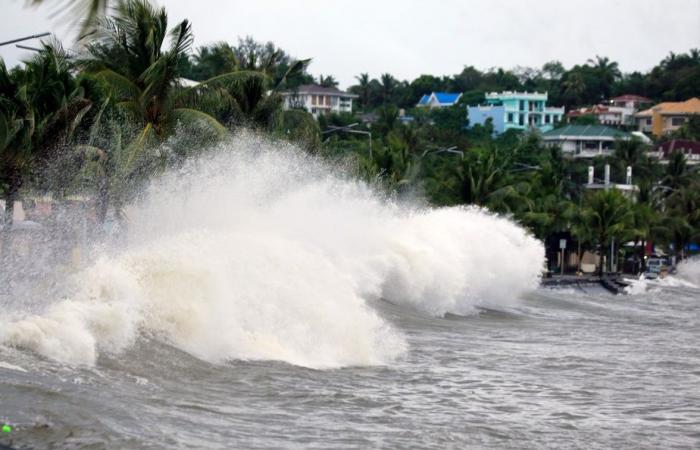(Manila) The super typhoon Man-yiwhich could have a “potentially catastrophic” impact on the Philippines, made landfall in the archipelago on Saturday, accompanied by gusts of up to 325 km/h and waves reaching up to 14 meters high, according to the meteorological services .
Posted at 12:12 p.m.
Cecil Morella
Agence France-Presse
More than 650,000 people fled their homes as the super typhoon approached, the sixth major storm to hit the Philippines in a month.
Winds reached up to 195 km/h when the super typhoon made landfall on the island province of Catanduanes in the Bicol region, with gusts of up to 325 km/h, the national weather agency said .
“A potentially catastrophic and life-threatening situation looms in the northeastern Bicol region as super typhoon Pepito “is further intensifying,” the weather agency said before landfall, using the storm’s local name and referring to the southern part of the main island of Luzon.
PHOTO CHARISM SAYAT, AGENCE FRANCE-PRESSE
Powerful waves were visible in Legazpi on Saturday.
Waves up to 14 meters high crashed onto the Catanduanes coastline and storm surges of more than three meters are likely to hit Manila and other vulnerable coastal areas within 48 hours, according to the weather agency .
The power had been preventively cut off in Catanduanes and the shelters are powered by generators.
“We are in the evacuation center and we hear sounds of falling and things breaking,” provincial disaster official Roberto Monterola told AFP.
“We cannot check what is damaged because the winds are too strong. It could be branches breaking off and falling onto roofs,” he added.
Previous storms have killed at least 163 people, left thousands homeless, destroyed crops and killed livestock.
Scientists say climate change is increasing the intensity of storms, leading to heavier rains, flash floods and stronger gusts.
Every year, around 20 major storms and typhoons hit the Philippines or its surrounding waters, killing dozens of people, but it is rare for several such weather events to occur in a short period of time.
Evacuations
Man-yi could hit Luzon – the country’s most populous island and economic engine – on Sunday afternoon, passing north of Manila and sweeping across the South China Sea on Monday.
On Saturday, the government called on the population to heed the warnings and take shelter.
“If a preventive evacuation is necessary, let’s do it and not wait for the hour of danger to evacuate or seek help, […] we will endanger not only our lives, but also those of our rescuers,” said Marlo Iringan, Undersecretary of the Interior.
In Albay province, Myrna Perea, her husband and three children found shelter in a classroom with nine other families after being ordered to flee their jailhouse.
The family spent Friday night on a shared mattress under the single fan hanging from the classroom ceiling. But Mme Perea, 44, felt it was better to be safe.
“That’s why we left.” Even if the house is destroyed, the important thing is not to lose a family member.”
A return “to the medieval era”
In Northern Samar province, disaster official Rei Josiah Echano blames typhoon damage for poverty in the region.
“Every time we have a typhoon like this, it takes us back to the medieval era,” he assures AFP.
All vessels, from fishing boats to tankers, have been ordered to stay in port or return to dock.
The mayor of the town of Naga, in the province of Camarines Sur, imposed a curfew from noon on Saturday in order to force residents to stay at home.
Man-yi hits the Philippines late in the typhoon season, with most cyclones developing between July and October.
Earlier this month, four storms formed simultaneously in the Pacific basin. The Japanese meteorological agency told AFP on Saturday that this was the first time such a phenomenon had been observed in November since its records began in 1951.







